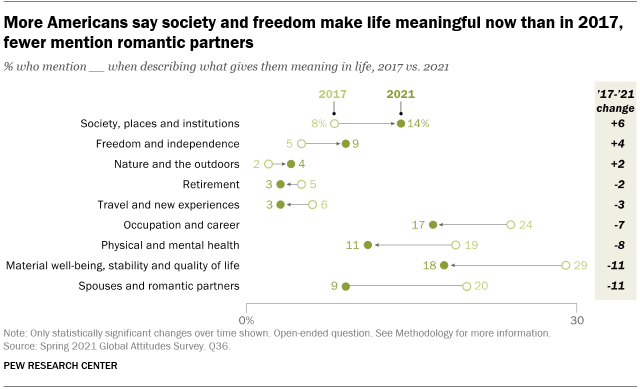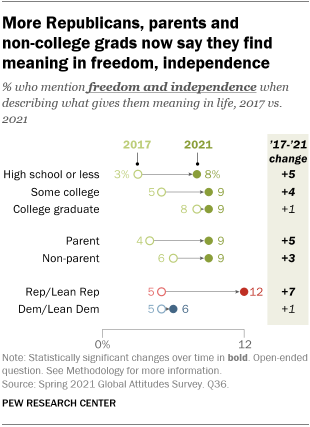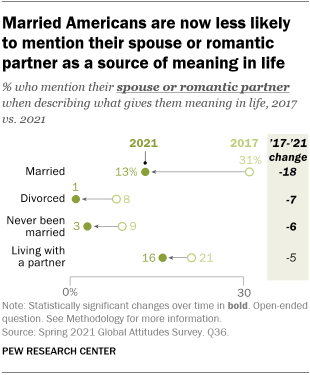Many things have changed in the United States in the past four years, from a new administration in Washington to the COVID-19 pandemic, which has disrupted work, financial security, family structures and even the ability to move around freely – to say nothing of its impact on public health.
Alongside these shifts, Americans have evolved in where they find meaning in their lives, according to a new Pew Research Center analysis of surveys conducted in September 2017 and February 2021. In both years, the Center asked a representative sample of U.S. adults to answer the following question in their own words: “What about your life do you currently find meaningful, fulfilling or satisfying? What keeps you going and why?”
Based on these surveys, here are six facts about where Americans find meaning in life and how those responses have shifted over the past four years. The analysis also examines how attitudes in the U.S. compare with those in 16 other advanced economies surveyed by the Center in 2021.
This Pew Research Center analysis examines Americans’ responses to an open-ended question about what gives them meaning in life and explores how responses in the United States have changed over time as well as how they differ from those elsewhere in the world. Details about the over-time analysis can be found in the Methodology for comparing 2017 and 2021 U.S. surveys on the meaning of life.
For this analysis, we conducted nationally representative surveys of 4,867 U.S. adults from Sept. 14 to 28, 2017, and 2,596 U.S. adults from Feb. 1 to 7, 2021. Everyone who took part in both surveys is a member of the Center’s American Trends Panel (ATP), an online survey panel that is recruited through national, random sampling of residential addresses. This way nearly all adults have a chance of selection. The surveys were weighted to be representative of the U.S. adult population by gender, race, ethnicity, partisan affiliation, education and other categories.
In both surveys, respondents were asked to answer the following open-ended question: “We’re interested in exploring what it means to live a satisfying life. Please take a moment to reflect on your life and what makes it feel worthwhile – then answer the question below as thoughtfully as you can. What about your life do you currently find meaningful, fulfilling or satisfying? What keeps you going and why?”
We also conducted nationally representative surveys of 16,254 adults from March 12 to May 26, 2021, in 16 advanced economies. All surveys were conducted over the phone with adults in Canada, Belgium, France, Germany, Greece, Italy, the Netherlands, Spain, Sweden, the United Kingdom, Australia, Japan, New Zealand, Singapore, South Korea and Taiwan. Responses are weighted to be representative of the adult population in each public. Respondents in these publics were asked a shorter version of the question asked in the U.S.: “We’re interested in exploring what it means to live a satisfying life. What aspects of your life do you currently find meaningful, fulfilling or satisfying?” Responses were transcribed by interviewers in the language in which the interviews were conducted.
Researchers examined random samples of English responses, machine-translated non-English responses and responses translated by a professional translation firm to inductively develop a codebook for the main sources of meaning mentioned across the 17 publics. The codebook was iteratively improved via practice coding and calculations of intercoder reliability until a final selection of 20 codes was formally adopted (read Appendix C of the full report).
To apply the codebook to the full collection of 18,850 responses, a team of Pew Research Center coders and professional translators were trained to code English and non-English responses, respectively. Coders in both groups coded random samples and were evaluated for consistency and accuracy. They were asked to independently code responses only after reaching an acceptable threshold for intercoder reliability. (For more on this, read Appendix A of the full report.)
Here is the question used for this analysis, along with the coded responses for each public. Open-ended responses included in the analysis and in the accompanying interactive have been lightly edited for clarity (and, in some cases, translated into English by a professional firm). Here are more details about our international survey methodology and country-specific sample designs. For respondents in the U.S., read more about the ATP’s methodology.
Americans have become more likely to mention society as a source of meaning in life, but much of this emphasis is negative. The share of Americans who mention society, places and institutions – which includes references to one’s local area, as well as to broader notions of the U.S., the government and social services – grew from 8% in 2017 to 14% in 2021. The increase was especially pronounced among those ages 65 and older (24% this year, up from 10%) and those without full-time jobs (17%, up from 8%).
As was the case in 2017, about half of adults who mention society (49%) bring up something negative, such as personal frustrations or difficulties. The nature of these complaints ranges widely, from economic concerns, distrust of government and partisan animosity to more general fears about the direction of the country. As one woman put it while reflecting on what she views as growing political extremism in America, “My hope is dimming because I see no light at the end of the tunnel.”
The U.S. stands out as one of only three publics surveyed in 2021 where mentions of society significantly coincide with greater negativity. The other two are Italy and Spain, but in neither of them is the relationship between society and negativity as strong as it is in the U.S.
Americans – especially Republicans – have become more likely to mention freedom and independence as a source of meaning in life. Among Americans overall, 9% now mention issues such as freedom, independence and their ability to do what they want to do, including financial independence, having free time or a good work-life balance, or political freedoms like freedom of speech. This is up from 5% in 2017.
Much of this increase has occurred among Republicans and independents who lean toward the Republican Party. This year, 12% of Republicans mention freedom or independence, up from 5% in 2017. There has been no significant change among Democrats and Democratic-leaning independents during this period (6% this year vs. 5% in 2017).
While Republicans in the U.S. are much more likely than Democrats to mention freedom or independence as a source of meaning in life, similar ideological divides are not evident elsewhere in the world. Mentions of freedom are not associated with right-leaning ideological views in any of the other 16 publics surveyed in 2021; in fact, in two other publics (Italy and Spain), such mentions are more common among those on the ideological left.
Mentions of freedom in the U.S. have become more common among other demographic groups, too. For example, while just 4% of parents mentioned the topic in 2017, 9% do so in 2021, matching the share of non-parents who currently mention freedom or independence as a source of meaning in life. Similarly, Americans without a college degree have become more likely to refer to the subject, now mentioning it at roughly the same rate as those with a college degree (9%).
Compared with 2017, fewer Americans now mention spouses or romantic partners as a source of meaning in life. Around one-in-ten U.S. adults (9%) now mention their spouse or romantic partner or their romantic or dating life, down from 20% in 2017. This represents one of the largest decreases across all of the sources of meaning coded as part of this project. While both married and unmarried people are now less likely to mention partners or romance, the decline has been greatest among married adults. Just 13% of married adults mention their spouse in 2021, down from nearly a third (31%) in 2017.
Despite the decline, Americans are among the most likely to mention their spouse or partner among all 17 places surveyed. Outside of the U.S., mentions of romantic partners are most common in the Netherlands (8%) and Italy (7%). But no more than 5% of adults in most other places mention their spouse or partner.
Fewer Americans now mention finances, jobs or travel as a source of meaning in life than in 2017. The share of U.S. adults who bring up their material well-being – including references to feeling safe, secure, able to cover the basics, living comfortably or being well-off – has dropped from 29% to 18% over the past four years. This decline has been concentrated among two groups in particular: married adults and White Americans. In 2017, both groups were among the most likely to point to material well-being as a source of meaning.
The share of adults who mention their job, occupation or career as a source of meaning has declined from 24% to 17% since 2017, perhaps reflecting the fact that many Americans’ working lives have been upended during the coronavirus pandemic. While Americans with higher incomes and those with a college degree remain the most likely to bring up their jobs, both groups have become less likely to do so, with a decline from 37% to 27% among those in the upper-income tier and a decline from 39% to 26% among the college-educated.
The widespread travel restrictions in response to the pandemic may have also affected the share of Americans who derive meaning from travel, which declined from 6% in 2017 to 3% in 2021. But the topic of travel remains more common among college graduates and those with a total family income of $100,000 or more per year.
Older Americans have grown less likely to mention their physical or mental health as a source of meaning in life. The overall share of Americans who mention their physical or mental health or wellness fell from 19% in 2017 to 11% in 2021. And this shift has been especially pronounced among older Americans. This year, only 12% of those ages 65 and older mention their health as a source of meaning, down from 30% in 2017.
The emphasis on health has also fallen significantly among White Americans, who now mention the topic at a similar rate as Black and Hispanic Americans. In 2017, by contrast, White adults were more likely than Black and Hispanic adults to mention their health.
Most Americans are no more likely to mention difficulties or challenges than they were four years ago, although older adults are an exception. Between 2017 and 2021, the share of Americans who mention some sort of negative circumstance or difficulty when describing where they find meaning in life has remained stable – 17% of all adults. But older Americans have become more likely to mention difficulties or challenges when answering this question. Roughly a quarter of those 65 and older (27%) mention a difficulty or challenge in 2021 – more than any other age group and more than the 20% who did so in 2017. This pattern does not appear to be unique to the U.S.: In many of the other publics where the Center asked the same question in 2021, older people are also more likely to mention these kinds of difficulties.








